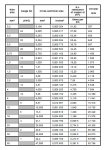Is anyone familiar with the European equivalent to AWG for wire gauge? Is there an official document somewhere that converts between the 2 units?
I know it is all done in metric units. But how would I indicate #10AWG? Do I say I need 2.59mm wire?
Also, would system of calculating fuse size also work for the European market? Is there a different way to calculate fuses in Europe?
I know it is all done in metric units. But how would I indicate #10AWG? Do I say I need 2.59mm wire?
Also, would system of calculating fuse size also work for the European market? Is there a different way to calculate fuses in Europe?

